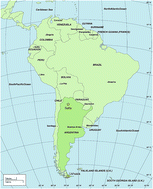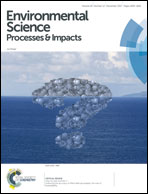Variations in serum concentrations of selected organochlorines among delivering women in Argentina. The EMASAR study†
Abstract
The EMASAR study is the first study to describe the body burden of OCs in Argentinian women after delivery. In total, 698 maternal serum samples from Salta (n = 498) and Ushuaia (n = 200) were collected in 2011–2012 and analyzed for a total of 7 polychlorinated biphenyls (PCBs) and 12 pesticide-related compounds. Only 11 of the compounds had detection rates above 60% in one or both places. Compared with Ushuaian women, those from Salta exhibited higher lipid-adjusted concentrations of p,p′-DDE, p,p′-DDT, β-HCH, and PCB 118 (p ≤ 0.003), with no differences in concentrations of PCB 153 and 138. After controlling for age, parity and heritage (born in the province or migrated there from other regions of Argentina), concentrations of p,p′-DDE, p,p′-DDT, β-HCH and all PCBs were significantly higher in Salta natives compared with Ushuaia natives or migrants (p ≤ 0.010). No variations between native and migrated Ushuaian women were observed other than for PCB 153 (6.1 versus 8.6 μg kg−1 lipid, p = 0.022). Age was generally associated positively with the body burden of nearly all OCs and parity negatively so, with p,p′-DDD, o,p′-DDT, and o,p′-DDD residues and α-HCH in Ushuaia being the exceptions. The regional differences in OC concentrations are explained by contrasting domestic sources, historical and current uses, industrial emissions, dietary patterns and lifestyle factors, as well as long-range-transport. The relatively high PCB 118/PCB 180 ratio observed for both Argentinian communities likely reflects the use of technical mixtures with congener-specific composition. In a comprehensive comparison with other countries, the Argentinian OC concentrations were mostly in the lower range. It is concluded that a latitude effect equivalent to that operative in the Arctic region seems unlikely.



 Please wait while we load your content...
Please wait while we load your content...